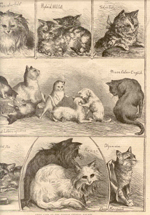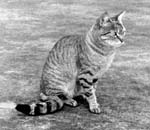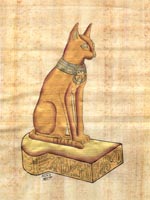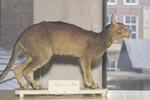History of the Abyssinian Cat

Within this section you will find information which will tell you a few things about where the breed may possibly have originated and/or how it was established.
 Many of the claims made about the breed's origin are probably more myth and fantasy than reality and controversy lingers on until today.
Many of the claims made about the breed's origin are probably more myth and fantasy than reality and controversy lingers on until today.  Almost any cat book talking about the breed will start with the theory that the first Abyssinian cat was brought to England by a British soldier, in 1868, returning from Abyssinia War (Ethiopia today). It's name is recorded to be "Zula" and believed to be the founder cat of the breed. Having a closer look at the picture published to be "Zula" one would however quickly agree it has practically nothing in ressemblence with the breed whether we look at pictures from early Abyssinians or at some more recent ones. The coat seems to be longish and waved rather than that of a shorthaired cat and ears are so tiny that many a modern Persian or Exotic would get embarrassed.
Almost any cat book talking about the breed will start with the theory that the first Abyssinian cat was brought to England by a British soldier, in 1868, returning from Abyssinia War (Ethiopia today). It's name is recorded to be "Zula" and believed to be the founder cat of the breed. Having a closer look at the picture published to be "Zula" one would however quickly agree it has practically nothing in ressemblence with the breed whether we look at pictures from early Abyssinians or at some more recent ones. The coat seems to be longish and waved rather than that of a shorthaired cat and ears are so tiny that many a modern Persian or Exotic would get embarrassed.
 Frances Simpson says in "The Book of the Cat" (London 1903) that the so-called Abyssinian cats of her time bore a 'very striking resemblance to the Egyptian or Caffre cat, and a picture of a painting in her book features an Abyssinian cat with ringed tail and many stripes on the legs. However, it is generally believed that all of today's domestic cats are descendants of the African Wild Cat (Felis Libyca).
Frances Simpson says in "The Book of the Cat" (London 1903) that the so-called Abyssinian cats of her time bore a 'very striking resemblance to the Egyptian or Caffre cat, and a picture of a painting in her book features an Abyssinian cat with ringed tail and many stripes on the legs. However, it is generally believed that all of today's domestic cats are descendants of the African Wild Cat (Felis Libyca).
Harrison Weir, on the other hand, had a somewhat less avantgardistic proposal about what may have created the unique look of the breed as it was shown around this time in England and says in "Our Cats and All About Them" (1889) that a cross between the English wild cat and a domestic cat had produced kittens similar to those imported from Abyssinia, so there obviously had been some from that country.
 The most romantic claim probably is the one, that the sacred cats pictured on ancient Egyptian artifacts and hieroglyphics must have been Abyssinian Cats and therefore
The most romantic claim probably is the one, that the sacred cats pictured on ancient Egyptian artifacts and hieroglyphics must have been Abyssinian Cats and therefore  suggest this breed to be one of the oldest in existence.
suggest this breed to be one of the oldest in existence.
With all those varied believes it may not be a surprise that no other breed had rejoiced in such varied names like Russian, Spanish, Abyssinian, hare cat, rabbit cat, bunny cat, British Tick, etc., with several countries claiming it as their own
Now, more recent research relying on DNA technology point more towards the fact that some of their ancestors must have had their roots closer to Asia than Africa. The Leiden Zoological Museum in Holland has an exhibit of a stuffed Abysinnian purchased in 1834-1836 labeled "Patrie, domestica India".
 It's also no secret anymore (though often still denied by even well established Aby Breeders) that other already established breeds have been used to found the Aby we see today. Siameses, Burmeses as well as Russian Blues are behind every modern Aby, although we may not always find these breed names explicitely even in an old pedigree and equally likely they were not the only ones used either
It's also no secret anymore (though often still denied by even well established Aby Breeders) that other already established breeds have been used to found the Aby we see today. Siameses, Burmeses as well as Russian Blues are behind every modern Aby, although we may not always find these breed names explicitely even in an old pedigree and equally likely they were not the only ones used either
 A few more things we know for certain are, that the breed was recognized in England by GCCF in 1929 and the first American Aby litter was born or recorded in 1935.
A few more things we know for certain are, that the breed was recognized in England by GCCF in 1929 and the first American Aby litter was born or recorded in 1935.
Almost 20 years later, in 1953, an Aby paw first touched Swedish grounds arriving from England founding Snorrehus cattery, and two years later another one (Selborne Catalpa) travelled via the sea way to New Zealand and started Finisterre Cattery in Auckland who in turn sent a couple of founder Abys to Australia starting 1959.
In France, there is documented existence of an Abyssinian Cat named "Ras Tafari" as early as 1927 (reference: "Les plus beaux chats de France", Gisèle Barney). In Holland, Abyssinian cat history began 1937 with Selesdune Buntibou, a British ruddy import, who founded Arke Noachs cattery. Her first litter was sired by Woodrooffe Zeus living in Paris and owned by Mme. Guyot. Due to world war II there are no offspring left of this line in current Abys and Netherland's Aby history was refounded in 1961 by Maria Falkena, whose famous cattery name Mariendaal is behind almost every Aby line throughout the world today. Denmark's breeding history of Abys started in 1950 with a British import called Croham Zara.
Submenu Breed History
- History of the Abyssinian Cat by Rosemond Peltz
- Journey From The Blue Nile
- The red (sorrel) Abyssinians in Books and History
- Red Abyssinians
- The Blue Abyssinian Cat and Its Derivatives
- Abyssinians in the Netherlands
- Early Breed Standard from 1889
- Abys in Europe in the 90s
- Abys in Europe in the 90s (Russian)

- SH Somalis
- Links

updated: March 2020
